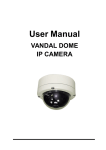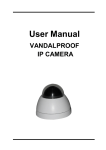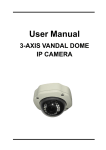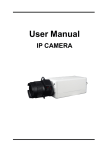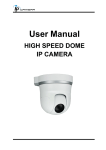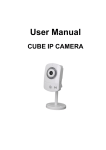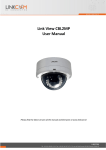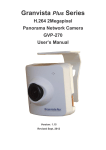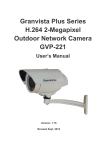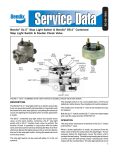Download User Manual - OV Solutions
Transcript
User Manual 3-AXIS VANDAL DOME IP CAMERA WARINGS TO REDUCE THE RISK OF FIRE OR ELECTRIC SHOCK, DO NOT EXPOSE THIS PRODUCT TO RAIN OR MOISTURE. DO NOT INSERT ANY METALLIC OBJECT THROUGH VENTILATION GRILLS. CAUTION CAUTION RISK OF ELECTRIC SHOCK DO NOT OPEN CAUTION: TO REDUCE THE RISK OF ELECTRIC SHOCK. DO NOT REMOVE COVER (OR BACK). NO USER-SERVICEABLE PARTS INSIDE. REFER SERVICING TO QUALIFIED SERVICE PERSONNEL. COPYRIGHT THE TRADEMARKS MENTIONED IN THE MANUAL ARE LEGALLY REGISTERED TO THEIR RESPECTIVE COMPANIES. CONTENT I. Preface 4 II. Product Specifications 4 III. Product Installation 5 A. MONITOR SETTING 5 B. HARDWARE INSTALLATION 6 C. IP Assignment 8 D. Install ActiveX control 10 E. Live Video 12 IV. IP Camera Configuration 14 A. System 15 B. Network 18 C. A/V Setting 29 D. Event List 36 V. Network Configuration 42 VI. I/O Configuration 43 VII. Factory Default 45 IX. Appendix 46 I. Preface This IP Camera is a IP Dome camera. It has the web server built in. User can view real-time video via IE browser. IP Camera supports simultaneously H.264, Motion JPEG & MPEG4 video compression and dual streaming which provides smooth and high video quality. The Pan/Tilt/Zoom function can be controlled remotely. The video can be stored in the SD card, and playback remotely. With user friendly interface, it is an easy-to-use IP camera which is designed for security application. II. Product Specifications • • • • • • • • • • • • • • • • Main Features: Full HD 1080P@30fps real time 1/2.7” 2Megapixel CMOS Sensor Digital Noise Reduction Digital Wide Dynamic Range Shutter Speed adjustment Sense Up adjustment Day&Night Switch time control manually IR-Cut filter IR Distance 15M Vandal proof Power over Ethernet available H.264/ M-JPEG / MPEG4 compression Micro SD card backup Support iPhone/Android/Mac Triple Streaming SDK for Software Integration For the detail specification , please refer to the data sheet III. Product Installation A. MONITOR SETTING 1. Right-Click on the desktop. Select “ Properties” 2. Change color quality to highest (32bit). B. HARDWARE INSTALLATION 1. Connect power adaptor first. 2. Connect IP Camera to PC or network 3. Set up the network configurations according to the network environment. For further explanation, please refer to chapter V: “Network Configuration for IP Camera”. 4. IP Camera Instruction Remove the dome cover, and you will see the structure as below. 5. Connector Instruction Connect the camera with power and Internet as the picture above. The following picture shows a DC 12V connector for adapter jack plug. About I/ O setting, please refer to chapter VI in User Manual: "I/O Configuration" for detail. 6. PoE ( Power Over Ethernet)(Optional) 802.3at, 30.0W PoE Switch is recommended Power over Ethernet (PoE) is a technology that integrates power into a standard LAN infrastructure. It enables power to be provided to the network device, such as an IP phone or a network camera, using the same cable as that used for network connection. It eliminates the need for power outlets at the camera locations and enables easier application of uninterruptible power supplies (UPS) to ensure 24 hours a day, 7 days a week operation. Ethernet PoE IP Camera PoE Switch Ethernet Cable Ethernet Cable PoE IP Camera C. IP Assignment 1. Use the software, “IP Installer” to assign the IP address of IP Camera. The software is in the attached CD. 2. There are two languages for the IP installer a. IPInstallerCht.exe: Chinese version b. IPInstallerEng.exe: English version 3. There are 3 kinds of IP configuration. a. Fixed IP (Public IP or Virtual IP) b. DHCP (Dynamic IP) c. Dial-up (PPPoE) 4. Execute IP Installer 5. For Windows XP SP2 user, it may popup the following message box. Please click “Unblock”. 6. IP Installer configuration: 7. IP Installer will search all IP Cameras connected on Lan. The user can click “Search Device” to search again. 8. Click one of the IP Camera listed on the left side. The network configuration of this IP camera will show on the right side. You may change the “name” of the IP Camera to your preference (eg: Office, warehouse). Change the parameter and click “Submit” then click “OK”. It will apply the change and reboot the Device. 9. Please make sure the subnet of PC IP address and IP CAM IP address are the same. The same Subnet: IP CAM IP address: 192.168.1.200 PC IP address: 192.168.1.100 Different Subnets: IP CAM IP address: 192.168.2.200 PC IP address: 192.168.1.100 To Change PC IP address: Control Panel→Network Connections→ Local Area Connection Properties→ Internet Protocol (TCP/IP) → Properties Please make sure your IP Camera and PC have the same Subnet. If not, please change IP Camera subnet or PC IP subnet accordingly. 10. A quick way to access remote monitoring is to left-click the mouse twice on a selected IP Camera listed on “Device list” of IP Installer. An IE browser will be opened. 11. Then, please key in the default “user name: admin” and “password: admin”. D. Install ActiveX control For the first time to view the camera video via IE, it will ask you to install the ActiveX component. If the installation failed, please check the security setting for the IE browser. 1. IE→Tools → Internet Options… → Security Tab → Custom Level… → Security Settings → Download unsigned ActiveX controls→ Select “Enable” or Prompt. 2. IE → Tools → Internet Options… → Security Tab → Custom Level… →Initialize and script ActiveX controls not marked as safe → Select “Enable” or Prompt. 1 2 3 4 5 When popup the following dialogue box, click “Yes”. E. Live Video Start an IE browser, type the IP address of the IP camera in the address field. It will show the following dialogue box. Key-in the user name and password. The default user name and password are “admin” and “admin”. When the IP Camera is connected successfully, it shows the following program interface. 1. :Get into the administration page 2. 3. 4. 5. :Video Snapshot Show system time, video resolution, and video refreshing rate. Adjust image, 1/2x, 1x, 2x. Select video streaming source. (When streaming 2 setting in『Video Setting』 is closed, this function will not display.) 6. 7. IP Camera supports 2-way audio. Click the “Chatting” check box. Then you can use microphone which connects to the PC to talk to server side, which is IP Camera side Control the relay output which is connected to this camera. Double-click the video to switch to full screen view. Press “Esc” or doubleclick the video again back to normal mode. Right-Click the mouse on the video, it will show a pop-up menu. 1. Snapshot: Save a JPEG picture 2. Record Start: Record the video in the local PC. It will ask you where to save the video. To stop recording, right-click the mouse again. Select “Record Stop”. The video format is AVI. Use Microsoft Media Player to play the recorded file. 3. Mute: Turn of the audio. Click again to turn on it. 4. Full Screen: Full-screen mode. 5. ZOOM: Enable zoom-in and zoom-out functions. Select “Enable digital zoom” option first within the pop-up dialogue box and then drag and drop the bar to adjust the zoom factors. IV. IP Camera Configuration Click page. to get into the administration page. Click to go back to the live video A. System 1. System Information a. Server Information: Set up the camera name, select language, and set up the camera time. (i) Server Name: This is the Camera name. This name will show on the IP Installer. (ii) Select language: There are English, Traditional Chinese, and Simplified Chinese to select. When change, it will show the following dialogue box for the confirmation of changing language. b. OSD Setting: Select a position where date & time stamp / text showing on screen. Moreover, click Text Edit can entry to adjust the OSD contents which is Alpha of text. Finally, click Upgrade button to reserve the setting. c. Server time setting: Select options to set up time - “NTP”, “Synchronize with PC’s time”, “Manual”, “The date and time remain the same”. 2. User Management IP CAMERA supports three different users, administrator, general user, and anonymous user. a. Anonymous User Login: Yes:Allow anonymous login No:Need user name & password to access this IP camera b. Add user: Type the user name and password, then click “Add/Set”. c. Click “edit” or “delete” in the user list to modify them. The system will ask you to key in the password in the pop-up window before you edit the user information. 3. System update: a. To update the firmware online, click “Browse…” to select the firmware. Then click “Upgrade” to proceed. b. Reboot system:re-start the IP camera c. Factory default:delete all the settings in this IP camera. d. Setting Management:User may download the current setting to PC, or upgrade from previous saved setting. (i) Setting download: Right-click the mouse button on Setting Download → Select “Save AS…” to save current IP CAM setting in PC → Select saving directory → Save (ii) Upgrade from previous setting: Browse → search previous setting → open → upgrade → Setting update confirm → click index.html. to return to main page B. Network 1. IP Setting IP Camera supports DHCP and static IP. a. IP Assignment (i) DHCP: Using DHCP, IP CAMERA will get all the network parameters automatically. (ii) Static IP: Please type in IP address, subnet mask, gateway, and DNS manually. b. IPv6 Assignment: IPv6 is a newer numbering system that provides a much larger address pool than IPv4, which accounts for most of today’s Internet traffic. You can set up IPv6 manually by key in Address, Gateway, and DNS, or enable DHCP to assign the IP automatically. c. Port assignment: (i) Web Page Port: setup web page connecting port and video transmitting port (Default: 80) (ii) HTTP Port:setup HTTPS connecting port (Default:443) d. UPnP (Universal Plug and play): This IP camera supports UPnP, if this service is enabled on your computer, the camera will automatically be detected and a new icon will be added to “My Network Places.” (i) UPnP Port Forwarding: Enable UPnP Port Forwarding can access the Network Camera from the Internet, select this option to allow the Network Camera to open ports on the router automatically so that video streams can be sent out from a LAN. There are three External port can be set, Web Port, Http Port and RTSP port. To utilize of this feature, make sure that your router supports UPnPTM and it is activated. (ii) Note: UPnP must be enabled on your computer. Please follow the procedure to activate UPnP. • open the Control Panel from the Start Menu • Select Add/Remove Programs • Select Add/Remove Windows Components and open Networking Services section • Click Details and select UPnP to setup the service • The IP device icon will be added to “MY Network Places” • User may double click the IP device icon to access IE browser e. RTSP setting (i) RTSP Server: enable or disable (ii) RTSP Port: setup port for RTSP transmitting (Default: 554) (iii) RTSP Start and End Port: in RTSP mode, you may use TCP and UDP for connecting. TCP connection uses RTSP Port (554). UDP connection uses RTSP Start and End Port. f. Multicast Setting (Based on the RTSP Server) Multicast is a bandwidth conservation technology. This function allows several users to share the same packet sent from IP camera. To use Multicast, appoint IP Address and port here. TTL means the life time of packet, the larger the value is, and the more users can receive the packet. To use Multicast, be sure to enable the function "Receive Multicast" in your media player. g. ONVIF Choose your ONVIF version and settings. h. Bonjour This function enables MAC systems to link to this IP camera. Key in the name here. i. LLTD If your PC supports LLTD, enable this function then you can check the connection status, properties, and device position(like IP address) of this IP Camera in the network map. 2. Advanced a. Https (Hypertext Transfer Protocol Secure): Https can help protect streaming data transmission over the internal on the higher security level. Https setting: Before setting new request, please remove old secure identification at Http connection type. (i) Created Request: remove secure identification in Created request mode. There is a warning message showing. Please set “Yes” to remove secure identification. (ii) Setting the secure identification and apply it. (iii) Installed Certificate: remove Certificate in .Installed Certificate mode. There will be a warning message to check again. (iv) There are two ways to set Certificate- Install Signed Certificate and Create Self-Signed Certificate. b. SNMP(Simple Network Management Protocol) SNMP provides a simple framework for administering networked hardware. To manage the IP camera, you have to prepare a MIB browser or similar tools first. SNMPv1, SNMPv2c, and SNMPv3 can be enabled simultaneously. (i) SNMPv1 and SNMPv2: The term "Community name" in SNMPv1 and SNMPv2c can be roughly regarded as key. The person who has the community name has the authority to read or edit the information of IP camera via SNMP. Tick the box to enable SNMPv1 or SNMPv2c protocol, and specify the community name for write(read and write) and read(read-only). The user who use read community name to access the IP camera cannot modify any data of this camera. (ii) SNMPv3: For data security reason, the authentication and encryption assurances are added when developing SNMPv3. The user has to give not only the security name( the same as "community name" in v1&v2c, or sometimes we call it "context name") but the password in order to access the IP camera. Please set security name, authentication type, authentication password, encryption type, encryption password of write and read respectively. The password must be 8~64 bits in length. Different from in SNMPv1 and v2c, the user have to create an account when using SNMPv3. In the account parameters, key in the security name and password you set in the camera to get accessing. (iii) SNMPv1/SNMPv2 Trap: Trap is a mechanism that allows the a managed device to send messages to manager instead of waiting passively for polling from the manager. Specify the trap event. When those events happen, the camera will send the ring message to the Trap Address, which is usually the manager's IP address. Trap Community means the community that can receive the trap message. • Cold Start: The camera starts up or reboots. • Setting changed: The SNMP setting is changed. • Network Disconnected: The network connection was broken down. (The camera will send trap messages after the network being connected again) • V3 Authentication Failed: A SNMPv3 user account tries to get authentication but failed. (Due to incorrect password or community) • SD Insert / Remove: A Micro SD card is inserted or removed. c. Access List: ”Enable IP address filter” can set IP address which can allow or deny to this camera. There are two options, single and range, for user to set the IP address. d. QoS/DSCP(Quality of Server/Differentiated Services Code-point): DSCP specifies a simple mechanism for classifying and managing network traffic and provide QoS on IP networks. DSCP is a 6-bit in the IP header for packet classification purpose. Please define the reserve for Live Stream, Event / Alarm and Management. e. IEEE 802.1x is an IEEE standard for port-based Network Access Control. It provides an authentication mechanism to device wishing to attach to a LAN or WLAN. The EAPOL protocol support service identification and optional point to point encryption over the local LAN segment. Please check what version of the authenticator and authentication server support. This camera supports EAP-TLS method. Please enter ID, password issued by the CA, then upload related certificates. 3. PPPoE & DDNS a. PPPoE: Select “Enabled” to use PPPoE. Key-in Username and password for the ADSL connection. Send mail after dialed: When connect to the internet, it will send a mail to a specific mail account. For the mail setting, please refer to “Mail and FTP” settings. b. DDNS: It supports DDNS (Dynamic DNS) service. (i) Enable this service (ii) Key-in the DynDNS server name, user name, and password. (iii) Set up the IP Schedule update refreshing rate. (iv) Click “Apply” (v) If setting up IP schedule update too frequently, the IP may be blocked. In general, schedule update every day (1440 minutes) is recommended (vi) DDNS Status • Updating: Information update • Idle: Stop service • DDNS registration successful, can now login • Update Failed, the name is already registered: The user name has already been used. Please change it. • Update Failed, please check your internet connection: Network connection failed. • Update Failed, please check the account information you provide: The server, user name, and password may be wrong. 4. Server setting There are three choices of server types available: Email, FTP and SAMBA. Select the item to display the detailed configuration options. You can configure either one or all of them. a. Mail Setting: To send out the video via mail of ftp, please set up the configuration first. b. FTP: To send out the video via mail of ftp, please set up the configuration first. c. Samba: Select this option to send the media files via a network neighborhood when an event is triggered C. A/V Setting 1. Image Setting For security and privacy purposes, there are three areas that can be set up for privacy. Click the Area button first, and then drag an area on the above image. Remember to save your settings. The masked area will not shown on both live view and recording image. Please refer to the details below for image settings: A. Brightness, Contrast, Hue, Saturation, Sharpness can be adjusted here. The available values are: -4, -3, -2, -1, 0, 1, 2, 3, 4. B. AGC: The sensitivity of the camera can adjust to the environmental lighting. Enable this function for getting brighter image on low light, but the level of noise may also increase. The available values are: 16x, 24x, 32x, 48x, 64x. C. Shutter Time: Choose the location of your camera or a fixed shutter time. The shorter the shutter time is the less light the camera receives and the image becomes darker , it can adjust by Day and Night. The available values are: Outdoor, Indoor, 1/30, 1/50, 1/60, 1/100, 1/120, 1/125, 1/250, 1/500, 1/1000, 1/10,000. Note: When you select a number in "Shutter Time", the shutter time will vary in a range and be controlled by camera automatically. The following table shows the shutter time options and corresponding range. D. Sense up: When enabled, provides a higher sensitivity in low light conditions by slowing the shutter speed. The available values are: 1/30, 1/15. E. D-WDR: This function enables the camera to reduce the contrast in the view to avoid dark zones as a result of over and under exposure. If the Input resolution is 30fps, the default value is fixed on ENABLED. The available values are: OFF, 1, 2, 3, 4, 5, 6, 7, 8. If the D-WDR is enabled the values for bright, dark and contrast can be adjusted. F. Anti Fog: Improve the image clarity on environments presenting high levels of fog or smoke. G. Lens Distortion Correction: Correct the image in the borders due to the lens angles. The available values are: OFF, 1, 2, 3, 4, 5, 6, 7, 8 H. Video Orientation: Flip or mirror the image. I. Day & Night: The camera can detect the light level of the environment. If you choose "Light Sensor Mode", the image will be turned black and white at night in order to keep a clear image. To set light sensor mode, appoint a lux standard of switching D/N. Current lux value is provided for reference. Under "Times Mode" the switch time of Color / Black and white will be according to the given time. You can also control it by choosing "Color" or "B/W”. J. Red / Blue gain: Set the values for Red / Blue gain. The available values are: -5, -4, -3, -2, -1, 0, 1, 2, 3, 4, 5 K. Denoise: This function is able to filter the noise and blur from the image and show a clearer view. You can set the values for 2D and 3D filters. 2. Video Setting Video System: NTSC or PAL Corridor Mode: 90 degrees, 270 degrees or none. On Corridor Mode please take note of the lens’ position. If Corridor Mode is set as 90 degrees or 270 degrees the relation of the image and the camera would be as the following: Image Position 0 degrees 90 degrees 270 degrees User may select 2 streaming output simultaneously: Streaming 1 Setting: Basic mode and Advanced mode Streaming 2 Setting: Basic mode, Advanced mode, and 3GPP mode a. Basic Mode of Streaming 1 and Streaming 2: (i) Resolution: There are 5 resolutions can be chosen: 1920x1080, 1280x720, ,640x480, 320x240, 176x144 (ii) Quality: There are 5 levels to choose: Best/ High/ Standard/ Medium/ Low The higher the quality is, the bigger the file size is. It might affect Internet transmitting speed if the file gets too large. (iii) Video Frame Rate: The video refreshing rate per second. In Streaming 1 you can choose up to 30 FPS, while in Streaming 2 only up to 15 FPS. (iv) Video Format: H.264, MPEG4, or M-JPEG (v) RTSP Path: Set the RTSP output connecting route b. Advanced Mode of Streaming 1 and Streaming 2: (i) Resolution There are 5 resolutions can be chosen: 1920x1080, 1280x720, ,640x480, 320x240, 176x144 (ii) Bitrate Control Mode There are CBR(Constant Bit Rate) and VBR (Variable Bit Rate) to be chosen. (iii) Video Quantitative The quality adjustment of VBR. You can choose 1~10 compression rate (iv) Video Bitrate The quality adjustment of CBR. You can choose 32kbps~8Mkbps. The higher the value is, the higher the image quality is. (v) Video Frame Rate The video refreshing rate per second. In Streaming 1 you can choose up to 30 FPS, while in Streaming 2 only up to 15 FPS. (vi) GOP Size It means “Group of Pictures”. The higher the GOP is, the better the quality is. (vii)Video Format: H.264,MPEG4, or M-JPEG (viii)RTSP Path: RTSP output connecting route In Streaming 2, the option under Advanced Mode has no difference with under Basic Mode. c. 3GPP Streaming mode: 3GPP mode fixed setting: 176x144 resolution, 5FPS, MPEG4 format (i) Enable or Disable 3GPP Streaming (ii) 3GPP Path: 3GPP output connecting route 3. Audio: IP Camera supports 2-way audio. User can send audio from IP Camera mic input to remote PC; User can also send audio from remote PC mic to IP Camera’s external speaker. a. Audio from IP camera built-in mic to local PC: select “Enable” to start this function. b. Adjust Volume of audio. c. Check “chatting” in the browsing page, then your voice can be propagated from PC to camera. The Audio will not be smooth when enable SD card recording function simultaneously. D. Event List IP Camera provides multiple event settings. 1. Event Setting To enable motion detection, tick Area 1/2/3. Click Area 1/2/3 in Area Setting, and draw an area on the preview screen. When motion is detected in the area, the word Motion! will be displayed on the live screen. The camera will send video or snapshot to specific mail addresses, trigger the output device, or save video to FTP/ Micro SD card/ Samba. By selecting save to SD card, the video or snapshot will be saved to the Micro SD card. Also, by ticking E-mail/ FTP/ Samba on the Log option, the motion detection log will be sent to E-mail/ FTP/ Samba simultaneously. • Interval: For example, when selecting "10 sec", once the motion is detected and the action is triggered, it cannot be triggered again within 10 seconds. • Based on the schedule: When the option box is ticked, only during the selected schedule time the motion detection is enabled. b. Tampering Detection When the camera view is covered, moved, hit by strong light, or out of focus, the tampering detection will be triggered, and send snapshot or video to mail/FTP/Samba/SD card, or trigger the external alarm. For example: Before Tampering Detection Before Tampering Detection Tampering Triggered (Defocused) Tampering Triggered (Lens Covered) Before Tampering Detection Before Tampering Detection Tampering Triggered (Glare) Tampering Triggered (Camera Moved) • Interval: The tampering detecting interval. Take the diagram below as example. The interval is set for 30 second; the camera lens is covered during 10 - 40 sec. At time point B, the camera compares the view with time point A, and sends an alarm when it founds that the lens is covered. At time point C, the camera compares the view with time point B, and sends an alarm when it founds that the lens is uncovered. c. Record File Choose one of the format, AVI or JPEG . d. Record Time Setting Set up the video recording time for Pre Alarm and Post Alarm when motion is detected, I/O, or other devices is triggered. Note: Pre/Post Alarm record time is base on record time setting and restricted to IP Cam built-in Ram memory. If the quantity of data is too huge or video quality too high, recording frame might drop or decrease on post alarm recording time. e. Network Dis-connected To avoid video loss, the camera will start to save the video to local SD card when it detect no network connection. The video recording will continuously be saved into SD card and divided into every 10 minutes a file until the network is reconnected successfully. The oldest file will be deleted if the capacity of SD card is full. This function is only enabled under wire connection. f. Network IP check: Key in the target IP address and interval. The camera checks once in a while according to the setting interval time that if it can link to the target IP address. If connection failed, the camera starts to save the video to SD card. 2. Schedule a. Schedule: After complete the schedule setup, the camera data will be recorded according to the schedule setup. b. Snapshot: After enable the snapshot function, user can select the storage position of snapshot file, the interval time of snapshot and the reserved file name of snapshot. c. Interval: The interval between two snapshots. 3. I/O Setting a. Input Setting: IP Camera supports input and output. When the input condition is triggered, it can send the video to some specific mail addresses, transmit the video to remote FTP server, trigger the relay, save video to local SD card or to SAMBA. b. Output Setting: "OnOff Switch" means the camera executes the action when triggered. "Time Switch" means the camera executes the action according to the interval you choose after triggered. 4. Log List Sort by System Logs, Motion Detection Logs and I/O Logs. In addition, System Logs and I/O Logs won’t lose data due to power failure 5. MicroSD card Choose “The 1st day” meads the recoding file will be keep one day. Example: It is five o’clock now. Choose “The 1st day”. The files will be kept from five o’clock yesterday to five o’clock today. Note:The use of the SD card will affect the operation of the IP Camera slightly, such as affecting the frame rate of the video. V. Network Configuration • Configuration 1: a. Internet Access: ADSL or Cable Modem b. IP address: One real IP or one dynamic IP c. Only IP Camera connects to the internet d. For fixed real IP, set up the IP into IP Camera. For dynamic IP, start PPPoE. • Configuration 2: a. Internet AccessL: ADSL or Cable Modem b. IP address: More than one real IP or one dynamic IP c. IP Camera and PC connect to the internet d. Device needed: Switch Hub e. For fixed real IP, set up the IP into IP Camera and PC. For dynamic IP, start PPPoE. • Configuration 3: a. Internet Access: ADSL or Cable Modem b. IP address: one real IP or one dynamic IP c. IP Camera and PC connect to the internet d. Device needed: IP sharing e. Use virtual IP, set up port forwarding in IP sharing. VI. I/O Configuration • I/O Connection Use the terminal block in the camera as below: a. Please connect the COM & N.O / N.C pin (depend on the device) to the external relay (buzzer) device. Or b. Please connect the GND &Alarm pin to the external Trigger Device. • I/O Setup a. Click I/O Setting from the system setup page via IE, and check “Out1” to enable I/O signal. b. Click ON/OFF from the setup main page via IE to control relay out signal. VII. Factory Default • To recover the default IP address and password, please follow the following steps. • Remove the power, Internet, and the dome cover. Press and hold the button as the picture below. • Connect power to the camera, and do not release the button during the system booting. • It will take around 30 seconds to boot the camera. • Release the button when camera finishes proceed. • Re-login the camera using the default IP (http://192.168.1.20), and user name (admin), password (admin). IX. Appendix The following is the Micro SD Card recommended: Transcend SanDisk SDHC class4 16GB SDHC class4 32GB SD class4 16GB SD class4 32GB SDHC class6 4GB SDHC class6 8GB SDHC class6 16GB SD class6 4GB SD class6 8GB SD class6 16GB SDHC class10 4GB SDHC class10 8GB SDHC class10 16GB SDHC class4 4GB SDHC class4 8GB SDHC class4 16GB SDHC class4 32GB














































